Join us in our trip to Egypt, October 2003
(There are a lot of pictures to download so please be patient if you do not have a high speed connection)
Chapter 1: Introduction to Egypt
Chapter 2: Abu Simbel and Aswan.
Chapter 3: Cruising Down the Nile.
Chapter 4: Kom Ombo and the Temple of Horus at Edfu.
Chapter 5: Karnak Temple at Luxor and the Temple of Hathor at Dendera.
Chapter 6: West Thebes and the Valley of the Kings and Queens.
The Gods of Egypt and Diagram of Temples.
Maps of Egypt and our Itinerary.
Fran enjoys going on cruises: The Caribbean, Alaska, Panama Canal, The Aegean. You name them and she will sign up without hesitation. Mountain climbing in Machu Picchu was not greeted with as much enthusiasm. So I learned my lesson. I told her I was going to take her on a cruise on The Ship of the Desert. She jumped at the opportunity.
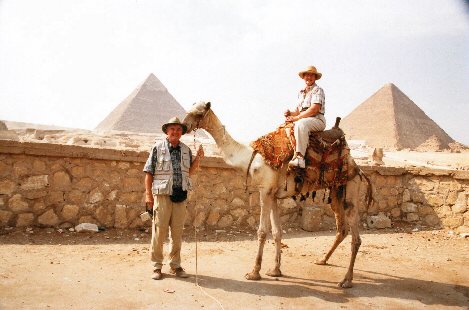
I don't think that this is what she had in mind but our view of the great pyramid of Khufo (Egyptian name - it is often called Cheops but that is the Greek spelling) and Sphinx were first rate. At least she didn't have to take any Dramamine. We found in our travels that there were many civilizations which had an impact on building the great tombs and temples in Egypt: Egyptians, Greeks, Romans, Coptic Christians, Muslims, and the Ottoman Empire. Often we saw temples which were expanded, and sometimes partially destroyed, by whomever happened to be in power at the time. The Coptic Christians defaced many of the temple reliefs because they depicted heathen gods (according to their belief - more about that later). Even a Pharaoh might rename a statue so it represented him and not someone from a previous dynasty. Very interesting indeed.
![]()
As you know, ever year for 38 years Fran and I have been sending out photo Christmas cards so people can see how we look and have a scene of something exciting we have done over the years. Well, this year we thought a picture of us with a camel would look nice. So, when we were in Giza, overlooking the great pyramid of Khufo (Cheops), and the pyramid of his son Khafre (Chefren) and the third pyramid of his grandson, Menkaure (Mycerinus), we thought it would make a great photo. (Remember, everything here has at least two names -- the original Egyptian name going back 5,000 years or so and the Johnny-come-lately Greek name only going back 2,500 years.)
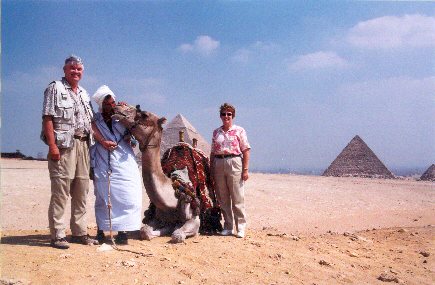
Well, there are problems with camels. They don't exactly do what they are told. This one would not stand, or sit, in the large open space between the pyramids of Khafre and Mankaure so we could have all three of them in the picture. So you only see the pyramid Khafre and Mankaure - the great pyramid of Khufo is hidden behind the camel driver (there is only one camel driver). The small pyramid you see to the far right of the picture was built for Mankaure's wives and family. Then to make matters worse the camel's owner wanted to demonstrate that he could kiss his favorite camel on the lips and would not get out of the picture. He offered us the opportunity to engage in this highly prized honor.
Fran said, "Oh ish!!"
The three pyramids are not the same size although the second pyramid of Mankaure (seen over the camel's saddle) looks larger than the great pyramid of Khafre because it is built on higher ground. The reason the three pyramids are not the same size, with each one getting smaller, is out of respect for Grandpa Khufo the founder of the dynasty. Finally, we are told that the pyramids are not all in alignment because they were intended to represent the alignment of the stars in the belt of Osiris. You can check out the belt of Osiris any night of the year merely by looking at the belt in the constellation of Orion (another Greek change). It was the Egyptian belief that when the pharaoh died he became one of the stars in the belt of Osiris.
![]()
The Story of a Stolen Horse
One thing you quickly understand in Egypt, and Israel and Jordan as well, is that you make a big mistake in applying our U.S. values, customs, cultures, and standard of living to the Middle East. I keep thinking about this when I see the news reports about how bad it is in Iraq. One thing to keep in mind, Egypt is not the U.S. For example.....
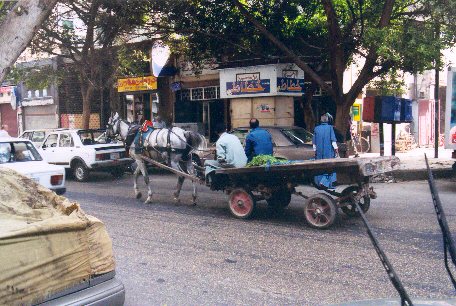
(Photo I took on a downtown Cairo street)
Now here is another example of the cultural divide. In one of the Cairo newspapers on Saturday, October 25, 2003, there was the following story. "A horse thief triggered a dramatic chase from the animal's owners, who had given him a good drubbing before dumping him into the Nile. A street vendor of gas butane cylinder was startled when he discovered, upon returning to his horse-drawn cart after delivering a cylinder to a house in the vicinity, that his animal had vanished into thin air. Suddenly, he saw a man on the back of his horse. With his two brother, they chased after the stranger until they stopped him on a Nile bride in northern Cairo where they beat him up before throwing him into the river. A rescue team was searching for the thief of whom no clue has been found yet."
Isn't this strange? Not a single condemnation of the three men who beat up the horse thief and threw him into the river where he probably drowned. The focus was "good triumphs over evil" and "swift and precise justice." Horses, donkeys, and camels are valuable pieces of property in Egypt because they are essential to making a living whether it is a farmer riding to the fields or his crop to the market or making deliveries to homes in the city. You see them everywhere overloaded with every imaginable cargo. Many of you may remember growing up with the milkman making daily deliveries to your home. Well, home delivery of almost everything is still available in Cairo.
![]()
Yesterday I mentioned Cairo being a city of 17,000,000 people and growing larger as you read this message. Well how crowded is it? I don't know if you remember my talking about riding on the bus in the mountains of Ecuador last year and we found that cars passed on the curving mountain roads even though there was a double yellow line - our guide told us that the yellow lines were "just a suggestion." Well, in Egypt we noticed that the buses didn't stay on their side of the road but often drove down the middle of the white line. In Cairo there were lane stripes painted on the roads for three lanes of traffic and there would be five lanes of cars. Our guide told us, "The lines in the road are only for decoration." LOL
Anyway, how bad is traffic? You know that I drive a motorcycle and people often complain about how motorcycles weave in and out of traffic. There is a similar problem in Cairo.
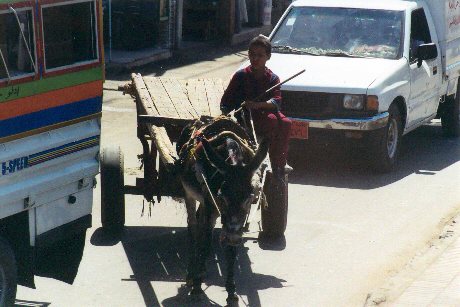
The difference is that a boy in the donkey cart travels faster than the traffic.
We generally didn't have that problem though. Tourism is the mainstay of the Egyptian economy. Egypt has been hit very hard by the lack of tourists since a terrorist attack on a group of Germans in Luxor in 1997 (more about that later) and the terrorist attack on New York on Sept 11, 2001. So, in order to provide security to the tourists we had a police escort everywhere. We were 131 people - 4 bus loads - touring Egypt. We got priority everywhere we went. It was like being in a funeral procession with police cars in front and behind stopping all traffic so we could turn when we got to a corner and we zipped right through the small towns and villages in the countryside. We had a tight schedule and had to get places in a hurry so it was useful in that respect; however, I like to take pictures of the people in the countryside and zipping through towns so fast without having to stop was not helpful.
But, don't let me get the cart before the horse
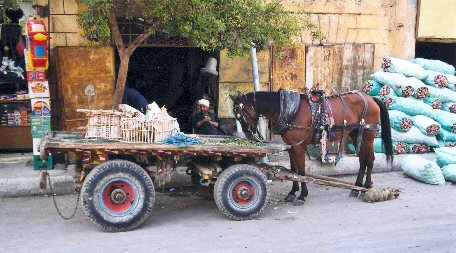
I have many other stories to tell.
![]()
Most of you have ridden on a bus at one time or another. If so you are familiar with the yellow line on the floor in the aisle just behind the driver's seat. The bus also will have a sign, "Stand behind the yellow line when bus is in motion." Well, there is no such admonition in the Cairo buses. The sign there is, "If you can hang on you can ride".
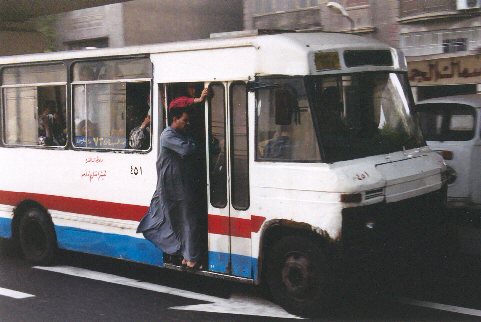
To say the least the buses are crowded. How crowded are they? Well, on several occasions we saw people getting off the bus at a stop by crawling out the windows rather than trying to make their way down the crowded aisles to the front door. Then a friend, or perhaps a fellow traveler, handed out the cage with chickens in it.
Public transportation in Cairo is of five kinds.
1. Buses without air conditioning - very cheap
2. Buses with air conditioning
3. Mini vans which head out in some direction and pick up people who are headed the same way - they don't run on a schedule and my take you a little out of the way but more conformable than the bus without air condition.
4. Taxies who start picking up people generally heading in the same direction and fill to capacity. May be a little faster than the mini van and they are more plentiful.
5. Private taxies, millions of them. Black and white is their color and you will recognize them by them blowing their horn as they drive by. They don't have any crazy sign which says "out of service" or "busy" or "occupied". If they have a passenger they drive on buy. If they are looking for a passenger they honk their horns at every person walking down the street to gain their attention. A private taxi may end up in category (4) above. When you buy a car in Cairo you don't worry if it is in good working order you only make sure it has a working horn.
Bob Peterson, a motorcycle friend, was in Egypt in 1995, and he had some comments about driving in Cairo which hold true today and which you may want to glance at: Driving in Cairo. (p.s. Bob says this is written in fun but there is a large element of truth in what he says. All I can say is you cross any street at your peril. LOL)
![]()
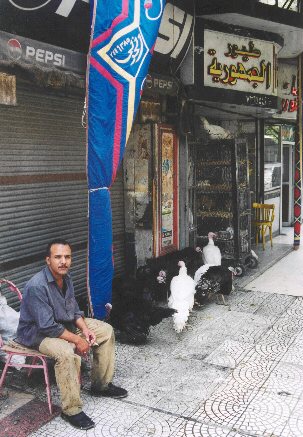
|
So you don't believe my story about someone handing a cage of chickens out the bus window? Well, just a block away from where I
saw that happen, and only two blocks from my hotel, on a major six lane street in Cairo I found this guy sitting in front of his
business on the sidewalk. Walking back and forth next to him were these turkeys. Why they didn't fly away I have no idea. Probably intimidated by the cabbies honking their horns You can see the cages in the right side of the picture. This is the "live produce" dealer selling his wares. |
| So you don't believe my story about someone handing a cage of chickens out the bus window? Well, just a block away from where I
saw that happen, and only two blocks from my hotel, on a major six lane street in Cairo I found this guy sitting in front of his
business on the sidewalk. Walking back and forth next to him were these turkeys. Why they didn't fly away I have no idea. Probably intimidated by the cabbies honking their horns You can see the cages in the right side of the picture. This is the "live produce" dealer selling his wares. Chickens, ducks, turkeys, and he was more than happy to pull out a rabbit for me to photograph. No going to Cub foods or Rainbow, or SuperValu for frozen food in Egypt - or Jordan for that matter. People want to choose their food and want it fresh. |
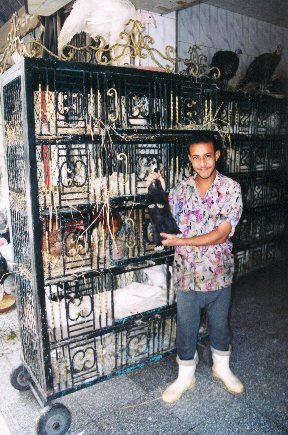 |
![]()
As you have probably figured out, one of the things that fascinate me on my travels are the open markets. So unique, full of character, and different from the sterile clean large super markets we are accustom to in the U.S. I mentioned this to my guide and told him that although going through a markets is an exciting one day adventure for me it must be a hard life for the people who have to struggle with it day after day after day. Quite the contrary I was told. The market is a social place where people gather and talk, and they get to pick the best of the fruits and vegetables and meats. Shops are small and right next together so you have your choice of many different fruits from many different venders. You are not forced into the dilemma of buying the wrong size or wrong variety tomato because the alternative is to drive several miles to another market and not be confident you will find what you are looking for there either.
For instance, if you are shopping for a fine cut of meat you get to pick it from the carcass, you don't find it already cut and packaged in cellophane, which may have had some red food dye added to give it the right color or maybe hide the age or the character of the meat by placing the bad side down in the package. This is not a take it or leave it operation. The meat is out for display and you choose what you want. And to make sure you don't confuse goat from sheep or beef they often leave the head hanging on the carcass, or place it in a dish on the ground.
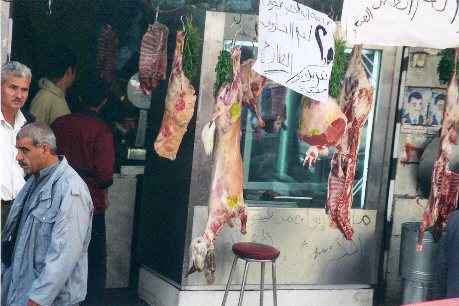
Of course, when the head is sold then it is gone. Nothing is wasted and everything is for sale. Fran was looking at a carcass hanging in the street in Cairo and the shop keeper told her it was fresh just that morning. He held his hand under the neck and showed her that it was still dripping blood. This is not shopping for the squeamish. If you don't like what you see in this store you can go to the next meat store just a few steps down the street.
My guide told me there are supermarkets in Cairo but few people use them. Shopping at the market is a way of life. As I learned in Peru, in many parts of the world cultures and customs change slowly. Also, only in the U.S. do we seem to live such a fast pace that we don't have time to talk to the butcher - in fact, in many supermarkets you can't even find the butcher.
![]()
![]()
![]()
Jump Station
Go to The Egyption Museum of Cairo - Under Construcion
Go to The Religious Faiths - Under Construction Go to Street Scenes of Cairo - Under Construction Go to Who are the Gods? - Under Construction. Go to Chapter 9: The Khan el-Khali Bazaar - Under Construction Go to Chapter 8: The Pyramids - Under Construction Go to Chapter 7: East Thebes and the Temple of Luxor - Under Construction Return to Chapter 6: The Pyramids.Return to Chapter 5: Karnak Temple at Luxor and the Temple of Hathor at Dendera.
>Return to Chapter 4: Kom Ombo, Edfu, Karnak and Dendera.
Return to Chapter 3: Cruising Down the Nile.
Return to Chapter 2: Abu Simbel and Aswan.
Return to Chapter 1: Introduction to Egypt.
Read about my version of The Gods of Egypt and Diagram of Temples.
Return to Belli's Home Page
Go to Chapter 2: Abu Simbel and Aswan
Maps of Egypt and our Itinerary.
Return to Belli's Home Page
![]()
For more information about our travels write to![]() Belli.
Belli.
